
(My reviews of older or classic books: https://dflewisreviews.wordpress.com/reviews-of-older-books/)
When I read this book, my thoughts will appear in the comment stream below…
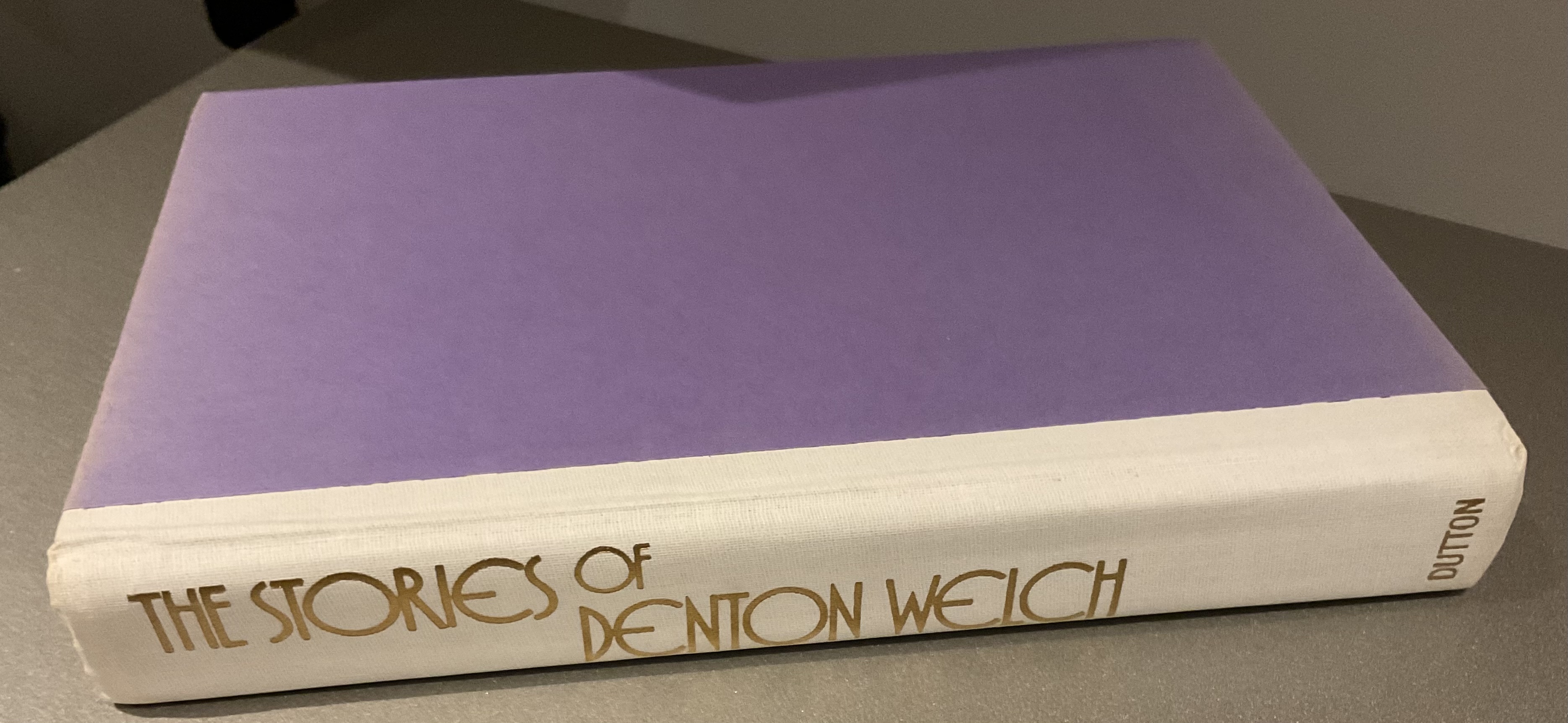

www.nemonymous.com
Des Lewis - GESTALT REAL-TIME BOOK REVIEWS
A FEARLESS FAITH IN FICTION — THE PASSION OF THE READING MOMENT CRYSTALLISED — Empirical literary critiques from 2008 as based on purchased books.

(My reviews of older or classic books: https://dflewisreviews.wordpress.com/reviews-of-older-books/)
When I read this book, my thoughts will appear in the comment stream below…

Book of Days – Steve Rasnic TemIn "crossroad press"
The 6th Fontana Book of Great Ghost Stories, edited by Robert AickmanIn "robert aickman"
The 5th Fontana Book of Great Ghost Stories, edited by Robert AickmanIn "robert aickman"
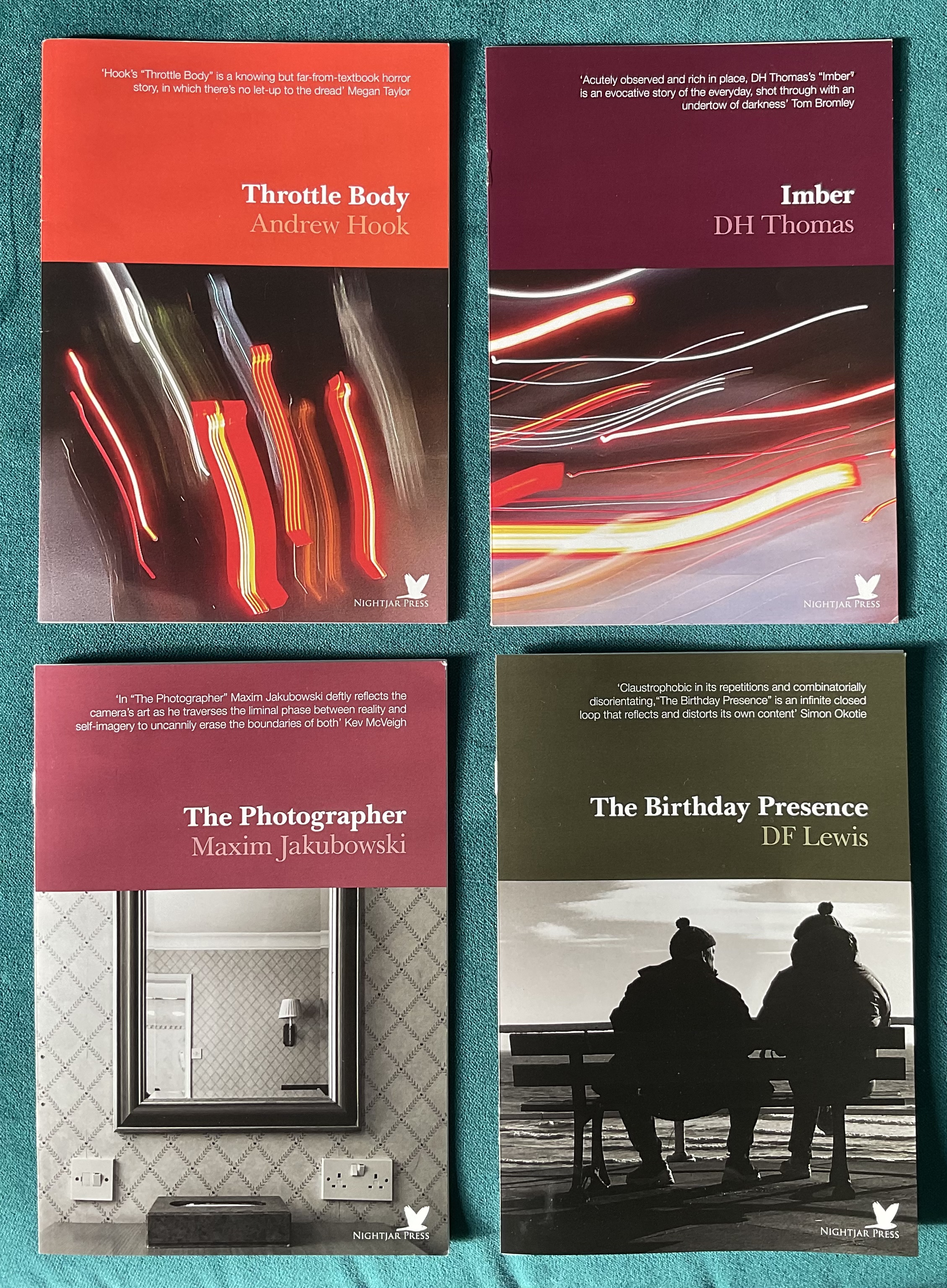
NIGHTJAR PRESS 2022 – my previous reviews of this publisher HERE
Throttle Baby by Andrew Hook, Imber by DH Thomas, The Photographer by Maxim Jakubowski, The Birthday Presence by me.
When I review (or re-view!) these fiction works, my comments will appear in the comment stream below…
The Hook – Florence Sunnen / Living Together – Matt ThomasIn "florence sunnen"
4 NightjarsIn "Andrew Humphrey"
MEDLAR by Joanne DoneIn "Joanne Done"
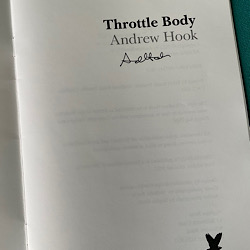 ”Nicholas!”
”Nicholas!”
This is a pervasively anxiety-driven story about a man driving his post-teen daughter in the car and half-swiping something or someone at the edge of woodland… and effectively making the incident into a hit and run that thereafter nags invasively the reader, perhaps worse than it does the man himself. The signature perhaps shows it was a squashed or scrawled deer-something after all? A man is one who lectures on ‘car crash culture’ and its film techniques, e.g. in connection with the tritely cinematic “zig-zagging” of hands and elbows miming the handling of the steering wheel in such crashing situations. And other cinematic sleights of hand. A story of idling, the agonising of stalling, worrying in hindsight and in interface with the grown-up daughter’s own thoughts on the matter and her later actions and requests, and the intriguing concept of ‘throttle body’, a day after I had to terrifyingly nurse my own car home quite a distance in second gear after the gearbox crashed. Perhaps I should have left the car behind, or read this story first. But impulses are peculiar things as are other things that interest me and make me anxious in this work: e.g. a reference to The Residents, a group that this author once wrote a whole book about that I reviewed, a second reference to ‘zigzag’, and here it is appositely a “zigzag across the pattern”, the pattern, as is my wont, that I try to give fiction works when reviewing them, and there are mentions of “elbow grease”, and of “connections no one would see other than him”, while I felt an obliquely geared empathy with him all the way through, wondering which words were crashed and which were left undamaged by my reading. I shall just wait for that knock on the door. It was my son with me, not my daughter, I shall tell them. Then to clean the porridge plates. And so much more to think about and to mention to you alongside different camera angles.
My previous reviews of Andrew Hook: https://dflewisreviews.wordpress.com/3228-2/
The above review is of THROTTLE BODY by Andrew Hook.
Cross-referenced Throttle Body later the same day with THAT DIETH NOT by H. Russell Wakefield here: https://dflewisreviews.wordpress.com/2022/10/28/the-frontier-guards-by-h-r-wakefield/#comment-25669
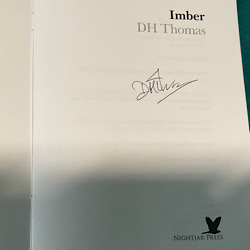 ”There were regular car crashes.”
”There were regular car crashes.”
A story not about my nightjar’s Thomas by another Thomas, but a story told about himself by a narrator who is working in a petrol garage at night on a road subject to even worse shunts than Hook’s, near Imber, I assume, info about which place I have factored into it. This narrator is a readerly, if not writerly, man, though his narration proves he is more writerly than otherwise, a man who did such night jobs here and in Taxi firm offices, and he has the parthenogenesis, if not photosynthesis, of his gestalt of photos he’d take of ready-mades and found art or simply offbeat objects he spontaneously chose to put into this Tarot pattern, as I will now do myself using this evocative narration of place and time in another car crash culture of shallow folk as well as ‘edgelords’: instead, though, I will photo a few of these with positive words rather than photo negatives… Costa machine, fridges, Tina’s videos, avant-garde noise as music, mowing a lawn after Viagra, the crucified Buster and the amazing car crash sting ending that makes Hook’s nightjar jar even more synergistic. Not forgetting, of course, Thomas’s trinity of peacocks on a cemetery wall.
Possible plot spoiler below, a blur that needs to be airbrushed, too…
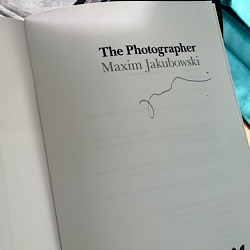
”I was getting old. And it scared me.”
It is as if the signature is slowly attenuating to nothing, too? As are eventually the serial photos taken of his nude body taken by Anaïs? The story of a writer, a narrator with whom Thomas in my own nightjar would empathise, well, at least, regarding the fact of having “measured my life by the books and stories I have written”, some SF, as it says in this nightjar, but not necessarily empathising with this narrator’s parade of women.
A very engaging work, effectively conveying the narrator’s sex and artistic and personal life and his photographing with more easy digital availability that Thomas would appreciate, my Thomas, not necessarily D.M. Thomas.
He was never a selfie man, he says. Wondrously characterised by narration about himself and about Anaïs, and their travels together in the potential Autumn of his years, an ‘improvised symphony’ of all those women with whom he had had sex. My equivalent symphony, in contrast, has a single, if complex and lengthy, movement. Significant that the first photo by Anaïs on her expensive camera that he saw of his naked self was in a Ukrainian restaurant? Dorian Gray, eat your heart out. My Thomas, meantime, would love the synergy…
“…I was more of an improviser of words on the page and an increasingly tired one at that.”
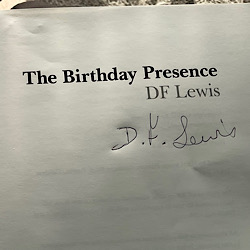 ”And they both laughed, as they passed each other on the zigzag slopes.”
”And they both laughed, as they passed each other on the zigzag slopes.”
This feels different now.
I will not be presumptuous enough to describe, interpret or evaluate this möbius section about Thomas in mutual synergy with Nightjar Press. Other than to say that I feel extremely proud and the experience has altered the state of my own self-regard, if not of any selfie. I will merely mention that the word ‘elbowing’ seems to have turned out to be at the most meaningfully personal core of this möbius! A word that is one of the very few in this work that is not repeated.
My signature has two dots, always has had! Thomas and me.
I am a selfie man, after all. The dome is the opposite of Jakubowski’s narrator’s attenuation!! It was the way it was taken. Or it is as real as it is now.
WHEN I WAS THIRTEEN
The story of the eponymous narrator being groomed by an older man called Archer at a ski resort, much to the eventual discovered disgust of tbr narrator’s older brother who was acting as guardian during this skiing holiday… Tellingly tactile with socks and old sweat and syrupy coffee, down to the peeled tangerine ‘pigs’, if not figs! Prehensilely Proustian. With slippery word meanings.
NARCISSUS BAY
Bay or boy?
A boy visiting his mother in China, and we witness a tranche of his life, such as a cruelty witnessed by him — four men and a woman, two of the men sadists, the other three victims — and cruelty he colluded in, with other children. Girls and their fat nurse who did jelly along, and, later, a boy he was friends with who cruelly taunted (something our boy witnessed) a third younger boy. Taunted him with jellyfish. And with a swordfish that comes up to attack your bottom when sitting in lavatories.
And our boy’s memories of the shrine in the hills nearby where Gods looked down… I wondered who kept whom at bay.
THE TROUT STREAM
“…I felt haunted. My mother’s sudden giddiness in the train had fixed my mind on pain and illness, so that I had been made specially conscious of Mr. Mellon’s useless legs; then I had crept into the drawing-room and seen that terrible starving man gnawed by rats.”
…the latter being an ivory carving. This is the classic I hoped to find in this book, a blend of Le Grand Meaulnes, Marcel Proust, Walter de la Mare and Robert Aickman.
The rite of passage in three distinct stages, with years between, of the narrator as a boy to a grown up. In interface with his mother, and when she died, his father, and the morphing households of Mr Mellon, the latter’s half-Japanese and/or half-Javanese servant Mrs Slade, and her daughter Phyllis roughly the same age as the narrator and grows up into what he sees as a ‘breasted’ woman, and she is made Mr M’s inheritrix. And not forgetting Bob, Mr M’s masseur, chauffeur and valet, with eyelids too small for his eyes. A sense of inferred sexuality between all these characters involved, even his mother with a stranger on a train. And the tiered landscapes of rock and land in the second stage of this story towards the eponymous stream, wherein tragedy is also inferred at the end of the third stage. Oh yes, also not forgetting the many Indian servants in the first stage of this story, and the pervasive white elephant that Mr M mentioned. I sensed hardness softening in walls and people. I wish I could forget some aspects of this stunning reading experience, though. Best not to mention such aspects here, as a means towards that wish.
“It was the counterfeit of a counterfeit.”
Leaves From A Young Person’s Notebook
“And suddenly I couldn’t understand what anything was for. The room seemed a riddle, the moaning of the sea, myself,…”
The powerfully disturbing notebook of what one would call, perhaps, a neurodiverse man now recovering from himself, as it were, in a nursing home on the East coast, not far, doubtless, from where I live at another resort on the same coast. We follow his thoughts as if with a direct current into our own thoughts, watching, alongside him, a rather cheeky girl in the road from the balcony, and surveying the iron lampposts as if they are isolated souls, and then he is threatening his own tantrums in the sun room, later escaping without leave, away from his leaves, for a while, into the road and then a pub, helping finish off graffiti of a woman in the pub loo so that she is more holy in her beauty, not brazen, an artistically pictorial stage-door to what role-play later? … back with Sister Howe at the home, burying himself in her ‘football bosom’, once he returns. An unmitigated glimpse into a soul that might once have been our own soul. Now no vacancy for any of us, even though we know more about him and others.
Self-abasement and ‘un-understanding’. The sound of the sea’s waves as the sound of the words in unending sentences…
THE BARN
“…then turned violently, making a superb chocolate fan on the emerald grass.”
One brother teaching whom I assumed was his his kid brother Denton to make proper skids when riding a bike. The art of skids. But then Denton, our narrator, is sent on an errand his brother refused, to Mrs. Singleton and Denton — who always feared, he tells us, old man dirt — finds her in corsets and suspenders around her ‘blancmange buttocks’, and later he does his make-believe or monkey exercises in an old barn that he considers to be his private place. Later his father allows a tramp to use the barn to sleep in because of the rain. And Denton visits him in the night, watching him sleep, despite the tramp’s own smells of dirt. Not an old man, though, a young 24 year old [“He looked beautiful. Then, as he suddenly awoke, his face broke into a cobweb of connecting lines..”], a tramp,who later calls Denton a ‘silly old bugger’ when Denton ask to go along with him and his wandering lifestyle. A story tranche, a fan of cobweb connections. Life is one long skid?
THE DIAMOND BADGE
“The heavy impasto was a little distasteful to me, and I found myself repeating the old phrase: ‘Excrement on canvas.’”
Or words on paper about this still life that the female narrator tells us about having been found in the house of Andrew, a famous writer whose book she had admired, and she wrote to him via the publisher, and was invited to tea, and was there looked after by Andrew’s manservant Tom and by Andrew himself (shrunken as well as deformed: reminiscent of the dwarf in another painting, one by Velásquez) — and they tend to her when she wakes with a nightmare in the night (her having been asked to stay after the supper as well as the tea!)
This story has the spirit of a Walter de la Mare story in its prose sensibility about nightingales, medieval coffins, a cocoon, a web of a thousand strands, Rubens ladies turned into telephone poles, Dresden china and much else, if not the sensibility of the characters themselves. Eventually, she deliberately leaves her eponymous diamond brooch in the bed before scuttling away before the two men wake up, so that Tom would contact her afterwards when returning it. Instead the brooch becomes the crucial prop in a short story, even though it is now re-badged.
This is a miracle of a story, one that held me throughout, and I would surely have regretted not reading it, should I ever become The Man Too iLL To Be Me! Not forgetting the ‘peculiar darns’ she put in Tom’s socks.
“…it is often impossible to understand the reason for one’s actions. How much more impossible to interpret the reasons of others.”
A FRAGMENT OF A LIFE STORY
“There is no doubt about it, I was overcome with the horror of living. It was too disgusting for any words.”
A tranche of the narrator’s neurodiverse problems, as magnified by the words he happens to write. His annoyance with a friend who takes him to a religious film, and a domino rally of severe frustrations with his doctor, as he intrudes into his house, the narrator’s visions, his over-dosing on his prescribed pills, self pity, self-destructiveness, but it may be, I thought, all show for this narration? Trying to shock us while he sat at home in relative calm? This photo I took as shown below may persuade many readers that this is no fictitious sham; nobody could pretend such a vision as anything other than what one sees, too, when being inspired by this story’s spire.
“You bucking feast, you ruggering bat!” I screamed.
THE COFFIN ON THE HILL
“I had the idea that a monk’s life was nothing but a waste of idleness, and I decided that they would all go mad in the end.”
Someone, presumably English, looking back to when he was eight years old and his parents — along with their Boy, Cook and Coolie — took him for a houseboat cruise on the river Yangtze from Shanghai, and as seen though his eyes, we share evocations of the sights he sees, and his fears of being dragged down by the current in the shape of creatures with monstrous tentacles, and other naive matters such as his doll (neither masculine nor feminine) whom he cherishes and the name of whom he knows but has never written down before, viz. Lymph Est. Which seems ironically pertinent to this particular reader today — when he recently knows he will soon or eventually perish by an invasion specifically of his Lymph. Not Est but Diest, I guess. And indeed this child faces death disarmingly amidst the picnics and other sight seeings. The monks and the granite incense burner with broken lip his parents are given by monks, a graveyard on a hill where in one grave he can see the rotted dead within. A coffin into which all of us, even his mother, will end up. And so defiantly, almost accidentally, almost deliberately, he drops the doll into the running, sucking river. An experiment to disprove the future’s dire rite of passage he dreads? Or just his own version of my own petulant attention-seeking? Some wondrous passages in this work.
ANNA DILLON
“She hoped he would ask no questions and tell her nothing.”
And here the author tells us nothing, expecting most readers to infer merely a plain story of the eponymous young woman, fatally iill, she says, of TB, yet she has a gold and diamond cigarette case that she foolhardily takes out with her, because she might lose it, into the countryside where she makes sketches. She only enjoys smoking when taking the white tubes from such a container. Foolhardily smoking, indeed. Silver fish jumping. Nostalgic bi-planes in the sky, during wartime. And she finds an airman sleeping whom she starts to sketch. Eventually she takes him home for tea, and they begin what what turns out to be potentially future romance, should he return from the dangers of night flights in the war. She loves the feel of his uniform’s material.
Simply that.
But I at least ask questions. Why is that cigarette case not ever mentioned again, as they dance to gramophone records on the wireless? Or is he merely a ghost of an airman? For many reasons, the latter is unlikely. But I think I definitely know the answer to the first, even though there is no evidence for it, other than his earlier saying to her: “…it’s just life — no use to kick and strain — got to take it as it comes.”
THE HATEFUL WORD
“; she felt the Adam’s apple rise and fall, like a squirrel leaping to escape, but tied by the leg.”
This is the touching story of a middle-aged lady picking up in England a German prisoner who looked to be in his twenties, someone who was let out by the camp during the day. Lonely, and at a loose end. Him or her? Both of them? Her husband ever brings his business clients home in his head when returning from London each day. She gets the prisoner to help with the garden on a regular basis. Until she felt his adam’s apple and later heard him say the hateful word that he called her, a spoiler to reveal the word here. I was intrigued by there being such phenomena as German prisoners let out for the day. A dated story that somehow never dates. Just the changing roles that equally never change.